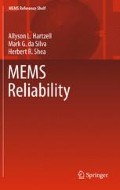Abstract
This chapter will cover strategies for identifying root cause and corrective action of reliability field failures. The MEMS reliability program must include strategies for identifying potential failure modes, failure mechanisms, risk areas in design and process, and containment strategies. Containment of the failure is crucial to achieving a low field failure rate while the root cause is determined and the proper corrective action is developed, checked for effectiveness, and then finally implemented into production.
Access this chapter
Tax calculation will be finalised at checkout
Purchases are for personal use only
References
Document SAE J 1739: Potential Failure Mode and Effects Analysis in Design (Design FMEA) and Potential Failure Mode and Effects Analysis in Manufacturing and Assembly Processes (Process FMEA) Reference Manual, SAE, 400 Commonwealth Drive, Warrendale, PA 15096–0001.
Bhattacharya, S., Hartzell, A. (2007) J. Micro/Nanolith, MEMS MOEMS, Jul–Sep 6(3), 033010-1–033010-12.
Stoney, G.G. (1909) The tension of metallic films deposited by electrolysis. Proc. R. Soc. London, Ser. A. 82(553), 172–175.
LaVern, A.S. (2002) PhD Thesis, Air Force Institute of Technology, April 2002 “Characterization of Residual Stress in Microelectromechanical Systems (MEMS) Devices using Raman Spectroscopy”.
Ken, G., et al. (2004) Creep of thin film Au on bimaterial Au/Si microcantilevers. Acta Materialia 52, 2133–2146.
Arthur Lin, Y. (1999) Parametric Wafer Map Visualization. IEEE Comput. Graphics Appl. 19(4), 14–17, (Jul/Aug).
Arman G., et al. (2000) Mechanical Reliability of Surface Micromachined Self-Assembling Two-Axis MEMS Tilting Mirrors. Prov. SPIE. 4180, MEMS Reliability for Critical Applications.
Wyko NT9100 Optical Profiling System, 2007 Veeco Instruments Inc. DS544, Rev A0.
Koev, S.T., Ghodssi, R. (2008) Advanced interferometric profile measurements through refractive media. Rev. Sci. Instrum. 79, 093702.
Goldstein J, Newbury DE, Joy DC, Lyman CE (2003) Scanning Electron Microscopy and X-ray Microanalysis. New York: Springer.
Kahn, H., Ballarini, R., Heuer, A.H. (2001) On the Fracture Toughness of Polysilicon MEMS Structures. Mat. Res. Soc. Symp. Proc. 657 (© 2001 Materials Research Society). 13–18.
Miller, D.C., et al. (2008) Connections between morphological and mechanical evolution during galvanic corrosion of micromachined polysilicon and monocyrstalline silicon. J. Appl. Phys. 103, 123518.
Guy F. Dirras, George Coles, Anthony J Wagner, Stephen Carlo, Caroline Newman, Kevin J. Hemker, William N. Sharpe, “On the Role of the Underlying Microstructure on the Mechanical Properties of Microelectromechanical Systems (MEMS) Materials” Materials Science of Microelectromechanical Systems (MEMS) Devices III, MRS Proceedings Volume 657.
Nunan, K., Ready, G., Sledziewski, J. (2001) LPCVD and PECVD Operations Designed for iMEMS Sensor Devices. Vacuum Coating Technol. 2(1), 26–37.
Gnauck, P., Hoffrogge, P. (2003) A new SEM/FIB Crossbeam Inspection Tool for high Resolution Mateirals and Device Characterization. Proc of SPIE. 4980, Reliability, Testing, and Characterization of MEMS/MOEMS II.
Walraven, J., et al. (2000) Failure analysis of tungsten coated polysilicon micromachined mircroengines. Proc. of SPIE. 4180, MEMS Reliability for Critical Applications.
Bharat, B., Huiwen, L. (2004) Micro/nanoscale tribological and mechanical characterization for MEMS/NEMS. Proc. of SPIE. 5392, Testing, Reliability and Application of Micro- and Nano-Material Systems II.
Loretto, M.H. (1984) Electron Beam Analysis of Materials. New York: Springer Science and Business Media.
Miller, D., et al. (2007) Thermo-mechanical evolution of multilayer thin films: Part II. Microstructure evolution in Au/Cr/Si microcantilevers. Thin Solid Films 515, 3224–3240.
Thornell, G., et al. (1999) Residual stress in sputtered gold films on quartz measured by the cantilevel beam deflection technique. IEEE Trans Ultrasonics, Ferroelectrics, Frequency Control, 46(4), July.
Alie, S., Hartzell, A., Karpman, M., Martin, J.R., Nunan, K. (2003) Optical mirror coatings for high-temperature diffusion barriers and mirror shaping United States Patent 6508561, Analog Devices.
Knieling, T., Lang, W., Benecke, W. (2007) Gas phase hydrophobisation of MEMS silicon structures with self-assembling monolayers for avoiding in-use sticking. Sensors Actuators B 126, 13–17.
Mowat, I., et al. (2007) Analytical methods for nanotechnology. NSTI Nanotech 2007 Proceedings, Santa Clara, May 20–24.
Tepolt, G.B. (2010) Hermetic vacuum sealing of MEMS devices containing organic components. SPIE 2010 Reliability, Packaging, Testing, and Characterization of MEMS/MOEMS and Nanodevices IX, Conference 7592.
Mastrangelo, C.H. (1999) Supression of Stiction in MEMS. MRS.
Mastrangelo, C.H., Hsu, C.H. (1992) A simple experimental technique for the measurement of work of adhesion of microstructures. Solid-State Sensor and Actuator Workshop, 1992, 5th Technical Digest, IEEE; 22–25 June.
Maboudian, R., Carraro, C. (2004) Surface chemistry and tribology of MEMS. Ann. Rev. Phys. Chem. 55, 35–54.
Wibbeler, J. et al. (1988) Parasitic charging of dielectric surfaces in capacitive microelectromechanical systems (MEMS). Sensor Actuators A 71, 74–80.
Reiter, G. et al. (1999) Destabilizing effect of long-range forces in thin liquid films on wettable surfaces. Europhys. Lett. 46(4), 512–518.
Danilov, V. et al. (2009) Plasma treatment of polydimethylsiloxane thin films studied by infrared reflection absorption spectroscopy. 29th ICPIG, July 12–17, Cancun, Mexico.
Author information
Authors and Affiliations
Corresponding author
Rights and permissions
Copyright information
© 2011 Springer Science+Business Media, LLC
About this chapter
Cite this chapter
Hartzell, A.L., da Silva, M.G., Shea, H.R. (2011). Root Cause and Failure Analysis. In: MEMS Reliability. MEMS Reference Shelf. Springer, Boston, MA. https://doi.org/10.1007/978-1-4419-6018-4_5
Download citation
DOI: https://doi.org/10.1007/978-1-4419-6018-4_5
Published:
Publisher Name: Springer, Boston, MA
Print ISBN: 978-1-4419-6017-7
Online ISBN: 978-1-4419-6018-4
eBook Packages: EngineeringEngineering (R0)

